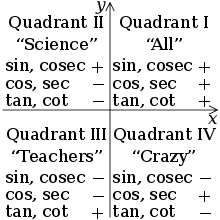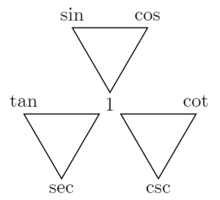Mnemonics in trigonometry
In trigonometry, it is common to use mnemonics to help remember trigonometric identities and the relationships between the various trigonometric functions.
SOH-CAH-TOA
The sine, cosine, and tangent ratios in a right triangle can be remembered by representing them as strings of letters, for instance SOH-CAH-TOA in English:
- Sine = Opposite ÷ Hypotenuse
- Cosine = Adjacent ÷ Hypotenuse
- Tangent = Opposite ÷ Adjacent
One way to remember the letters is to sound them out phonetically (i.e. /ˌsoʊkəˈtoʊ.ə/ SOH-kə-TOH-ə).
Another method is to expand the letters into a sentence, such as "Some Old Horses Chew Apples Happily Throughout Old Age," "Some Old Hippy Caught Another Hippy Tripping On Acid," or "Studying Our Homework Can Always Help To Obtain Achievement." The order may be switched, as in "Tommy On A Ship Of His Caught A Herring" (tangent, sine, cosine) or "The Old Army Colonel And His Son Often Hiccup" (tangent, cosine, sine).[1][2] Communities in Chinese circles may choose to remember it as TOA-CAH-SOH, which also means 'big-footed woman' (Chinese: 大腳嫂; Pe̍h-ōe-jī: tōa-kha-só) in Hokkien.
An alternate way to remember the letters for Sin, Cos, and Tan is to memorize the nonsense syllables Oh, Ah, Oh-Ah (i.e. /oʊ ə ˈoʊ.ə/) for O/H, A/H, O/A. Or, to remember all six functions, Sin, Cos, Tan, Cot, Sec, and Csc, memorize the syllables O/H, A/H, Oh/Ah, Ah/Oh, H/A, H/O (i.e. /oʊ ə ˈoʊ.ə əˈoʊ hə ˈhoʊ/). Longer mnenmonics for these letters include "Oscar Has A Hold On Angie" and "Oscar Had A Heap of Apples."[1]
All Students Take Calculus

All Students Take Calculus is a mnemonic for the sign of each trigonometric functions in each quadrant of the plane. The letters ASTC signify which of the trigonometric functions are positive, starting in the top right 1st quadrant and moving counterclockwise through quadrants 2 to 4.
- Quadrant I (angles from 0 to 90 degrees, or 0 to π/2 radians): All trigonometric functions are positive in this quadrant.
- Quadrant II (angles from 90 to 180 degrees, or π/2 to π radians): Sine and cosecant functions are positive in this quadrant.
- Quadrant III (angles from 180 to 270 degrees, or π to 3π/2 radians): Tangent and cotangent functions are positive in this quadrant.
- Quadrant IV (angles from 270 to 360 degrees, or 3π/2 to 2π radians): Cosine and secant functions are positive in this quadrant.
Other mnemonics include:
- All Stations To Central[3]
- All Silly Tom Cats[3]
- Add Sugar To Coffee[3]
- All Science Teachers (are) Crazy[4]
- A Smart Trig Class[5]
Other easy-to-remember mnemonics are the ACTS and CAST laws. These have the disadvantages of not going sequentially from quadrants 1 to 4 and not reinforcing the numbering convention of the quadrants.
- CAST still goes counterclockwise but starts in quadrant 4 going through quadrants 4, 1, 2, then 3.
- ACTS still starts in quadrant 1 but goes clockwise going through quadrants 1, 4, 3, then 2.
Hexagon chart

Another mnemonic permits all of the basic identities to be read off quickly. Although the word part of the mnemonic used to build the chart does not hold in English, the chart itself is fairly easy to reconstruct with a little thought. Functions without "co" appear on the left, co-functions on the right, a 1 goes in the middle, triangles point down, and the entire drawing looks like a fallout shelter trefoil.[6]
Starting at any corner of the hexagon:
- The starting corner equals one over the opposite corner.
- Going either clockwise or counter-clockwise, the starting corner equals the next corner divided by the corner after that.
- The starting corner equals the product of its two nearest neighbors.
- The sum of the squares of each item at the top of a triangle equals the square of the item at the bottom. These are the trigonometric Pythagorean identities:
Aside from the last bullet, the specific values for each identity are summarized in this table:
| Starting function | ... equals one over the opposite | ... equals the first over the second, going clockwise | ... equals the first over the second, going counter-clockwise | ... equals the product of two nearest neighbors |
|---|---|---|---|---|
References
- Weisstein, Eric W. "SOHCAHTOA". MathWorld.
- Foster, Jonathan K. (2008). Memory: A Very Short Introduction. Oxford. p. 128. ISBN 0-19-280675-0.
- "Sine, Cosine and Tangent in Four Quadrants". Archived from the original on 2015-01-18. Retrieved 2015-01-18.
- Heng, Cheng and Talbert, "Additional Mathematics", page 228
- "Math Mnemonics and Songs for Trigonometry". Retrieved 2019-10-17.
- "Magic Hexagon for Trig Identities". Math is Fun.